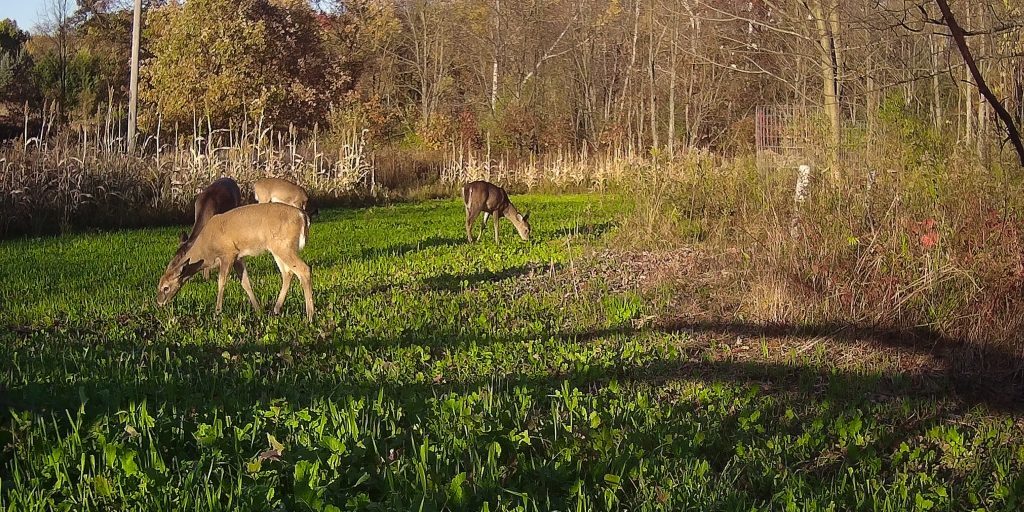One of my favorite things to do is pull soil samples and send them to Ward Labs for analysis. I have been blessed to manage the same farm for over a decade. The fields, and results – although improving – are far from surprising. This year was different, this year I got a chance to help manage a brand-new farm in NE Ohio. Everything about this farm is different, from the topography to the soil types to the surrounding agricultural practices. Once we found the 3 acres we were going to plant and bush-hogged off the area, it was time to get the soil probe out and take some samples!
As a point of reference, you can see the soil results above. Due to this being a brand-new field and fairly sizeable, I divided this into three, one-acre sections. Then in each of these sections, I took multiple samples, to give me a solid grid collection area within the sections. I am very happy to see the consistency across the field and results (this implies that my sampling techniques were homogenous and we don’t need to remove any outliers from the equation).
Now, this field has not been farmed for decades. The majority of the farm is heavy brush and brambles, with a few intersecting tree lines full of oak and hickory trees. We carved out this small section to create our 3-acre food plot. One might assume, due to the promotion of no-till, that this field would be loaded with nutrients, I mean – it hasn’t been worked or planted in YEARS, right? Wrong!!
Let’s dive in – although the above-ground biomass and root structures are going to eventually release nutrients, we are in a major nutrient tie-up situation here. Woody plants have been growing and absorbing nutrients for years. The lack of N fixing plants in the field further reduces its ability to cycle nutrients – as we want for a crop or food plot production field. Although this field has been “not tilled” for decades, without the focus on C: N rotations and nutrient cycling, all we have accomplished is bio-mass buildup and tie-up.
How do we know we are having an N tie-up? Well for one the inherent makeup of the field’s plant species were woody types, which are going to be higher in C: N ratios, which will take longer to break down. Correlatively to our soil test results, you can see our nitrate readings at 6inchs, are almost non-existent. Our organic matter percentage is decent but relative to the CEC of our soils, and the fact it has not been tilled in decades, further shows that just letting a field fallow, without management, will not build our OM. Lastly, as we look at our base saturations, we see they are not nearly where we’d like them to be for this CEC type, driving the point home further that leaving a field fallow for decades will not create good soil on its own.

So, what is next?
The first thing we will do is get lime down. The PH needs to be raised, as do both our CA and MG base saturations. Simply by getting our PH in balance, and our CA to MG base saturations, we will have a major impact on the soil structure and nutrient availability. This will not happen overnight but will be our point of focus for the next couple of years.
This year we were not able to get into this field for Spring planting. This field would have done very well with our Nitro-boost as it could use some legumes natural N fixing abilities. However, we need to work with the cards we were dealt, so we will be starting in the fall. We will be letting the grass green up and doing a chemical burndown in August. We will then seed our highly diverse Carbon-Load mix into the dying thatch. This will help to prime the pump, for next Spring’s Nitro-Boost planting. Due to the extremely low amount of nitrate available in the soil, no plantings being done before this fall planting to help promote N-fixation, and a large amount of high C: N biomass/thatch on the surface that needs to be broken down – we will likely use a foliar/starter N, humic acid, and micros application at the time of seeding to help jump start this degraded system.
Over time, by using no-till practices and our 1-2 system from Vitalize Seed that focuses on nutrient cycling, we will wean off the need for fertilization and only amend to balance CA, MG, and PH, on occasion.
Not any one soil is the same, but we love pulling soil samples and coming up with a plan based on the history of that location to ensure success for the growers.
Thank you for considering Vitalize Seed as your seed supplier.

